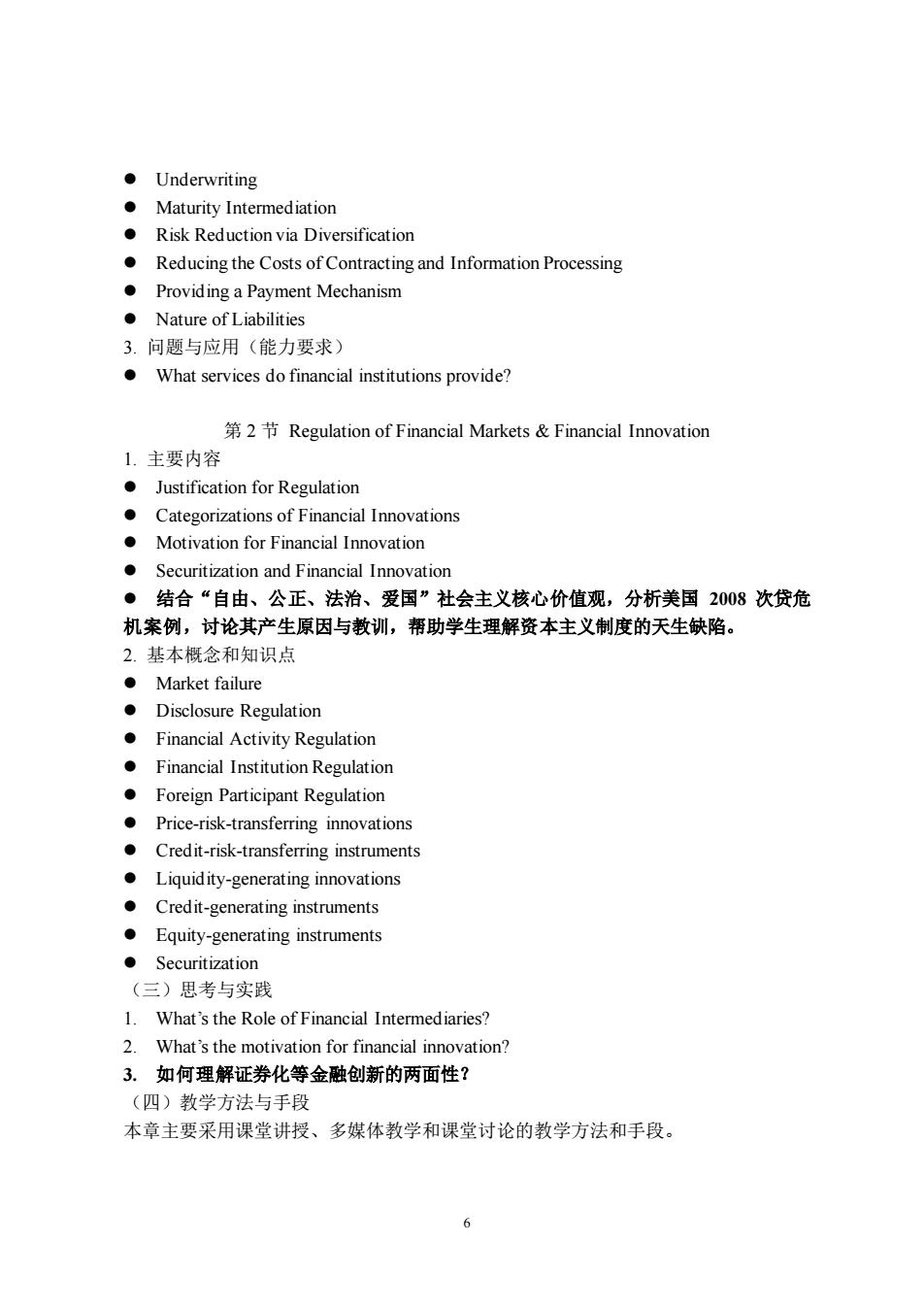
●Underwriting Maturity Intermediation Risk Reduction via Diversification Reducing the Costs of Contracting and Information Processing o Providing a payment Mechanism Nature of Liabilities 3.问题与应用(能力要求) What services do financial institutions provide? 2 Regulation of Financial Markets Financial Innovation 1.主要内容 Justification for Regulation Categorizations of Financial Innovations Motivation for Financial Innovation Securitization and Financial Innovation ●结合“自由、公正、法治、爱国”社会主义核心价值观,分析美国2008次贷危 机案例,讨论其产生原因与教训,帮助学生理解资本主义制度的天生缺陷。 2.基本概念和知识点 ●Market failure Disclosure Regulation Financial Activity Regulation Financial Institution Regulation Foreign Participant Regulation Price-risk-transferring innovations Credit-risk-transferring instruments Liquidity-generating innovations Credit-generating instruments Equity-generating instruments ●Securitization (三)思考与实践 1.What's the Role of Financial Intermediaries? 2.What's the motivation for financial innovation? 3.如何理解证券化等金融创新的两面性? (四)教学方法与手段 本章主要采用课堂讲授、多媒体教学和课堂讨论的教学方法和手段。 6
6 ⚫ Underwriting ⚫ Maturity Intermediation ⚫ Risk Reduction via Diversification ⚫ Reducing the Costs of Contracting and Information Processing ⚫ Providing a Payment Mechanism ⚫ Nature of Liabilities 3. 问题与应用(能力要求) ⚫ What services do financial institutions provide? 第 2 节 Regulation of Financial Markets & Financial Innovation 1. 主要内容 ⚫ Justification for Regulation ⚫ Categorizations of Financial Innovations ⚫ Motivation for Financial Innovation ⚫ Securitization and Financial Innovation ⚫ 结合“自由、公正、法治、爱国”社会主义核心价值观,分析美国 2008 次贷危 机案例,讨论其产生原因与教训,帮助学生理解资本主义制度的天生缺陷。 2. 基本概念和知识点 ⚫ Market failure ⚫ Disclosure Regulation ⚫ Financial Activity Regulation ⚫ Financial Institution Regulation ⚫ Foreign Participant Regulation ⚫ Price-risk-transferring innovations ⚫ Credit-risk-transferring instruments ⚫ Liquidity-generating innovations ⚫ Credit-generating instruments ⚫ Equity-generating instruments ⚫ Securitization (三)思考与实践 1. What’s the Role of Financial Intermediaries? 2. What’s the motivation for financial innovation? 3. 如何理解证券化等金融创新的两面性? (四)教学方法与手段 本章主要采用课堂讲授、多媒体教学和课堂讨论的教学方法和手段
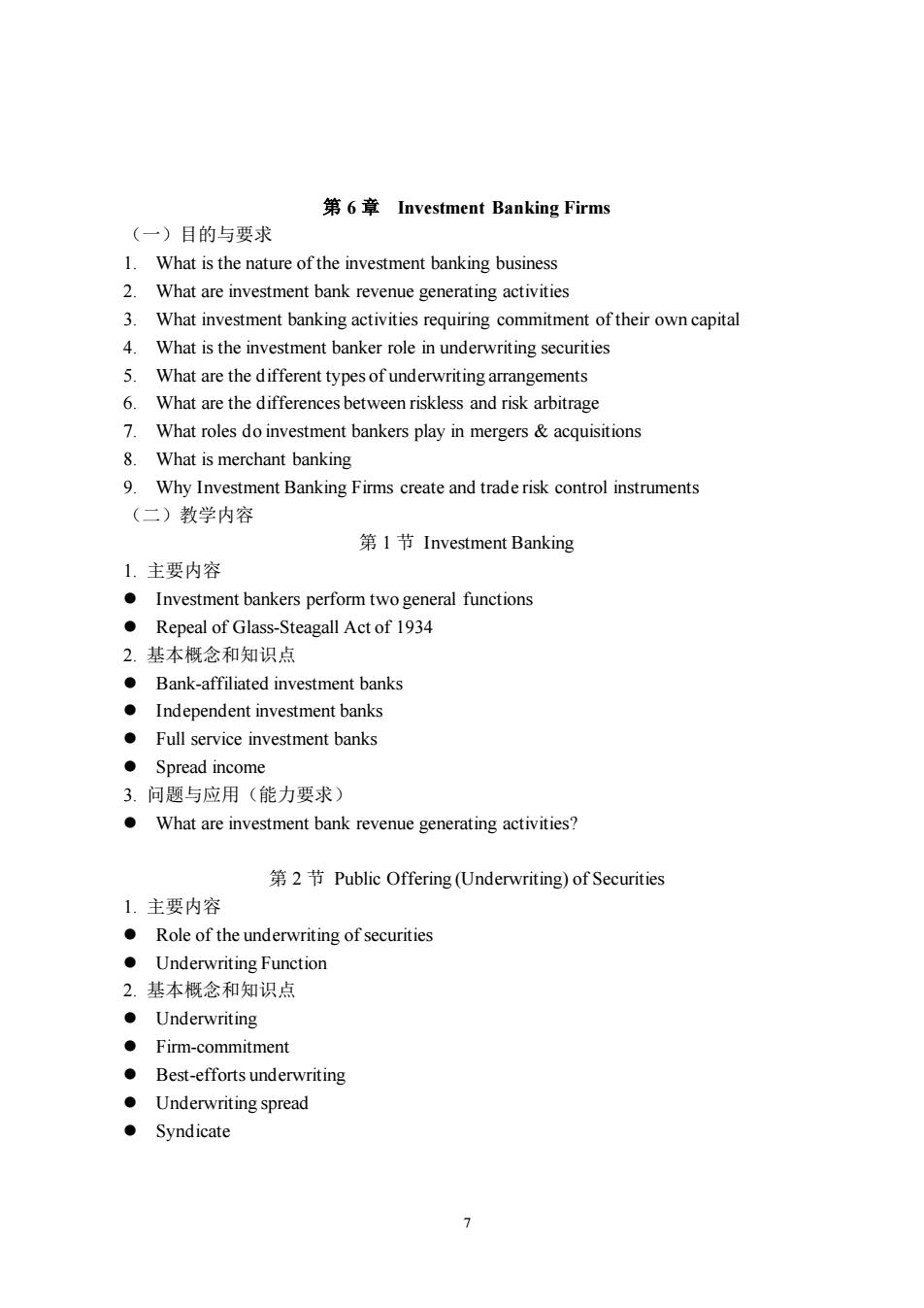
第6章Investment Banking Firms (一)目的与要求 1.What is the nature of the investment banking business 2.What are investment bank revenue generating activities 3.What investment banking activities requiring commitment of their own capital 4.What is the investment banker role in underwriting securities 5.What are the different types of underwriting arrangements 6. What are the differences between riskless and risk arbitrage 1. What roles do investment bankers play in mergers acquisitions 8.What is merchant banking 9.Why Investment Banking Firms create and trade risk control instruments (二)教学内容 第I节Investment Banking 1.主要内容 Investment bankers perform two general functions Repeal of Glass-Steagall Act of 1934 2基本概念和知识点 Bank-affiliated investment bank: Independent investment banks Full service investment banks ●Spread income 3.问题与应用(能力要求) What are investment bank revenue generating activities? 2Public Offering(Underwriting)of Securities 1.主要内容 Role of the underwriting of securities .Underwriting Function 2.基本概念和知识点 ●Underwriting ●Fimm-commitment o Best-efforts underwriting ●Underwriting spread ●Syndicate
7 第 6 章 Investment Banking Firms (一)目的与要求 1. What is the nature of the investment banking business 2. What are investment bank revenue generating activities 3. What investment banking activities requiring commitment of their own capital 4. What is the investment banker role in underwriting securities 5. What are the different types of underwriting arrangements 6. What are the differences between riskless and risk arbitrage 7. What roles do investment bankers play in mergers & acquisitions 8. What is merchant banking 9. Why Investment Banking Firms create and trade risk control instruments (二)教学内容 第 1 节 Investment Banking 1. 主要内容 ⚫ Investment bankers perform two general functions ⚫ Repeal of Glass-Steagall Act of 1934 2. 基本概念和知识点 ⚫ Bank-affiliated investment banks ⚫ Independent investment banks ⚫ Full service investment banks ⚫ Spread income 3. 问题与应用(能力要求) ⚫ What are investment bank revenue generating activities? 第 2 节 Public Offering (Underwriting) of Securities 1. 主要内容 ⚫ Role of the underwriting of securities ⚫ Underwriting Function 2. 基本概念和知识点 ⚫ Underwriting ⚫ Firm-commitment ⚫ Best-efforts underwriting ⚫ Underwriting spread ⚫ Syndicate
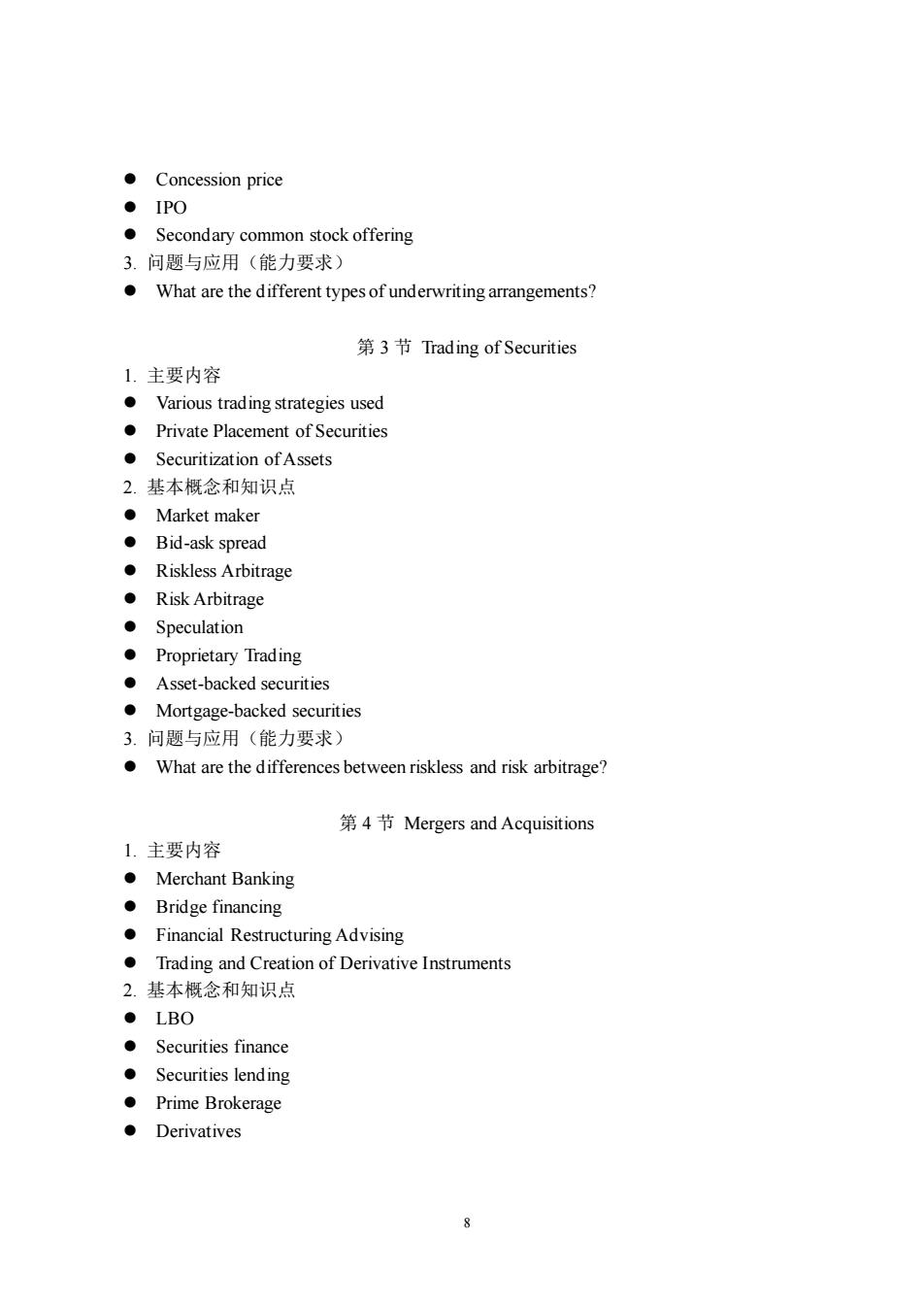
●Concession price ●IPO Secondary common stock offering 3.问题与应用(能力要求) o What are the different types of underwriting arrangements? 第3节Trading of Securities 1.主要内容 Various trading strategies used Private Placement of Securities Securitization ofAssets 2.基本概念和知识点 ●Market maker ● Bid-ask spread ●Riskless Arbitrage ●Risk Arbitrage ●Speculation ●Proprietary Trading Asset-backed securities Mortgage-backed securities 3.问题与应用(能力要求) What are the differences between riskless and risk arbitrage? 第4节Mergers and Acquisitions 1.主要内容 ●Merchant Banking ·Bridge financing Financial Restructuring Advising Trading and Creation of Derivative Instruments 2.基本概念和知识点 LBO ●Securities finance ● Securities lend ing ●Prime Brokerage ●Derivatives
8 ⚫ Concession price ⚫ IPO ⚫ Secondary common stock offering 3. 问题与应用(能力要求) ⚫ What are the different types of underwriting arrangements? 第 3 节 Trading of Securities 1. 主要内容 ⚫ Various trading strategies used ⚫ Private Placement of Securities ⚫ Securitization of Assets 2. 基本概念和知识点 ⚫ Market maker ⚫ Bid-ask spread ⚫ Riskless Arbitrage ⚫ Risk Arbitrage ⚫ Speculation ⚫ Proprietary Trading ⚫ Asset-backed securities ⚫ Mortgage-backed securities 3. 问题与应用(能力要求) ⚫ What are the differences between riskless and risk arbitrage? 第 4 节 Mergers and Acquisitions 1. 主要内容 ⚫ Merchant Banking ⚫ Bridge financing ⚫ Financial Restructuring Advising ⚫ Trading and Creation of Derivative Instruments 2. 基本概念和知识点 ⚫ LBO ⚫ Securities finance ⚫ Securities lending ⚫ Prime Brokerage ⚫ Derivatives
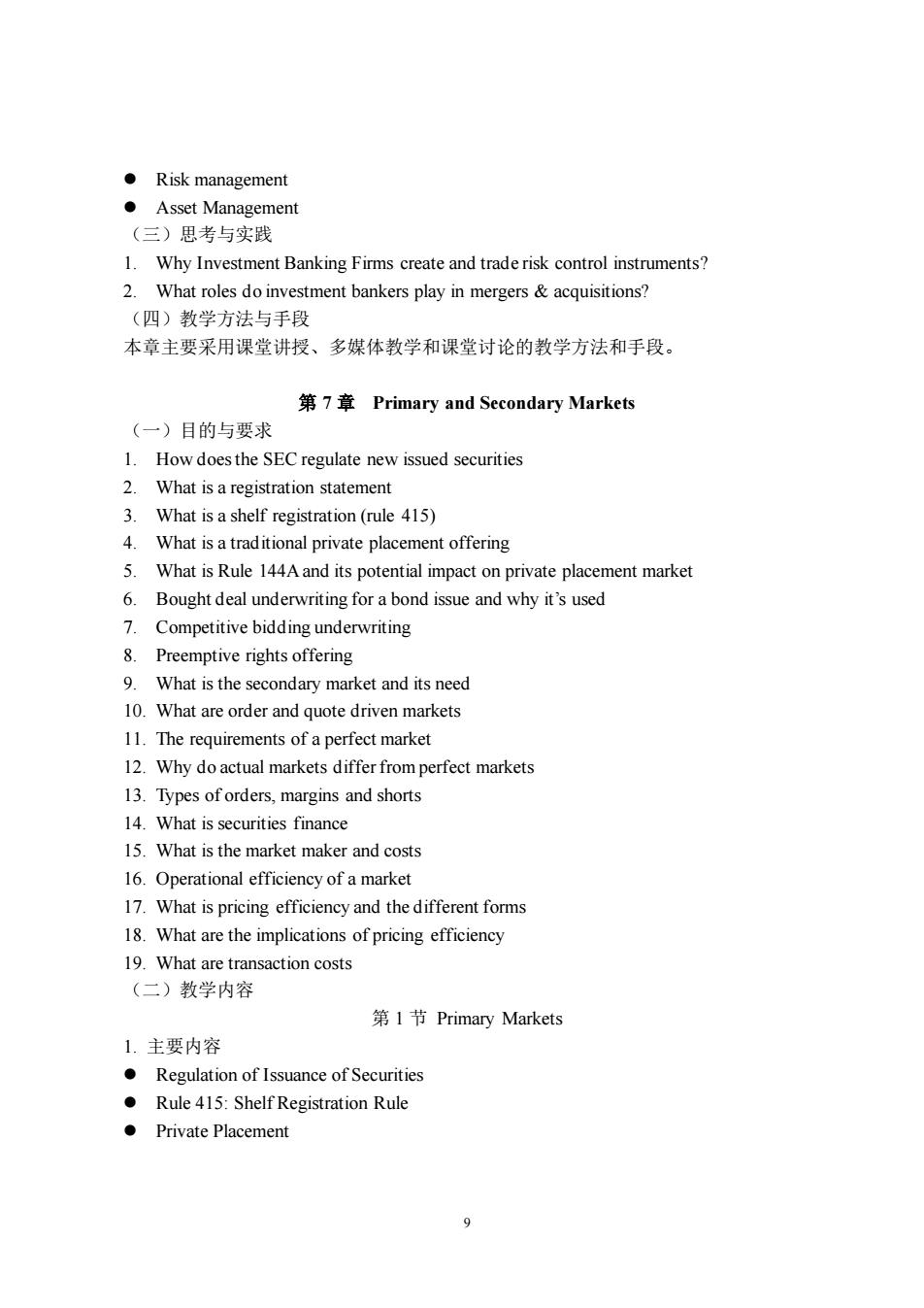
●Risk management ●Asset Management (三)思考与实践 1.Why Investment Banking Firms create and trade risk control instruments? 2.What roles do investment bankers play in mergers acquisitions? (四)教学方法与手段 本章主要采用课堂讲授、多媒体教学和课堂讨论的教学方法和手段。 第7章Primary and Secondary Markets (一)目的与要求 1.How doesthe SEC regulate new issued securities 2.What is a registration statement 3.What is a shelf registration(rule 415) 4.What is a traditional private placement offering 5.What is Rule 144A and its potential impact on private placement market 6.Bought deal underwriting for a bond issue and why it's used 7.Competitive bidding underwriting 8.Preemptive rights offering 9.What is the secondary market and its need 10.What are order and quote driven markets 11.The requirements of a perfect market 12.Why do actual markets differ from perfect markets 13.Types oforders,margins and shorts 14 What is securities finance 15.What is the market maker and costs 16.Operational efficiency of a market 17.What is pricing efficiency and the different forms 18.What are the implications of pricing efficiency 19.What are transaction costs (二)教学内容 第1节Primary Markets 1.主要内容 o Regulation of Issuance of Securities Rule 415:Shelf Registration Rule ●Private Placement
9 ⚫ Risk management ⚫ Asset Management (三)思考与实践 1. Why Investment Banking Firms create and trade risk control instruments? 2. What roles do investment bankers play in mergers & acquisitions? (四)教学方法与手段 本章主要采用课堂讲授、多媒体教学和课堂讨论的教学方法和手段。 第 7 章 Primary and Secondary Markets (一)目的与要求 1. How does the SEC regulate new issued securities 2. What is a registration statement 3. What is a shelf registration (rule 415) 4. What is a traditional private placement offering 5. What is Rule 144A and its potential impact on private placement market 6. Bought deal underwriting for a bond issue and why it’s used 7. Competitive bidding underwriting 8. Preemptive rights offering 9. What is the secondary market and its need 10. What are order and quote driven markets 11. The requirements of a perfect market 12. Why do actual markets differ from perfect markets 13. Types of orders, margins and shorts 14. What is securities finance 15. What is the market maker and costs 16. Operational efficiency of a market 17. What is pricing efficiency and the different forms 18. What are the implications of pricing efficiency 19. What are transaction costs (二)教学内容 第 1 节 Primary Markets 1. 主要内容 ⚫ Regulation of Issuance of Securities ⚫ Rule 415: Shelf Registration Rule ⚫ Private Placement
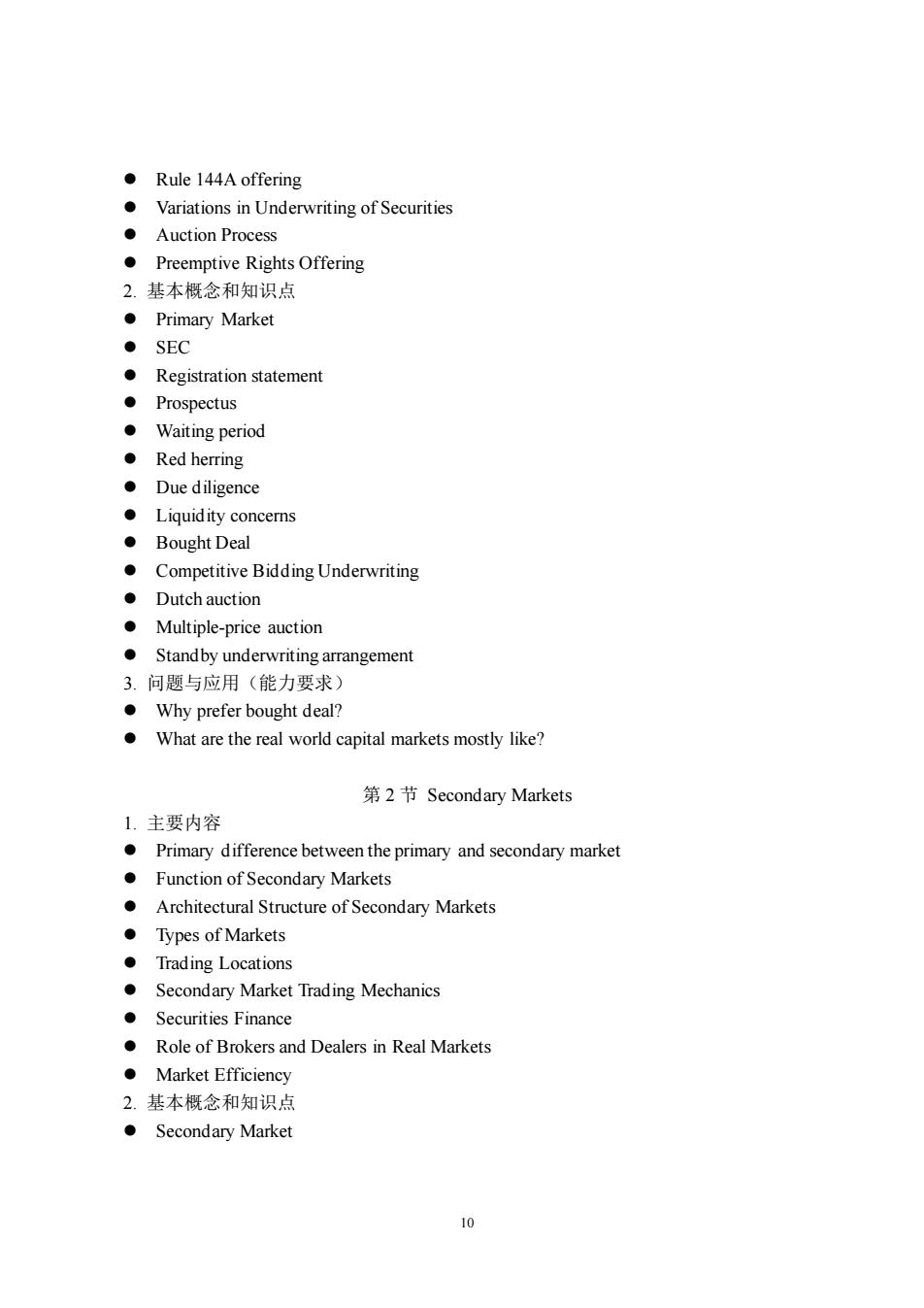
●Rule144 A offering Variations in Underwriting of Securities ●Auction Process Preemptive Rights Offering 2.基本概念和知识点 ●Primary Market ●SEC Registration statement ●Prospectus ●Waiting period ●Red herring ●Due diligence ●Liquidity concerns ●Bought Deal Competitive Bidding Underwriting ●Dutch auction Multiple-price auction Standby underwriting arrangement 3.问题与应用(能力要求) Why prefer bought deal? What are the real world capital markets mostly like? 第2节Secondary Markets 1.主要内容 Primary difference between the primary and secondary market Function of Secondary Markets Architectural Structure of Secondary Markets ·Types of Markets ●Trading Locations o Secondary Market Trading Mechanics ●Securities Finance Role of Brokers and Dealers in Real Markets ●Market Efficiency 2.基本概念和知识点 ● Secondary Market 10
10 ⚫ Rule 144A offering ⚫ Variations in Underwriting of Securities ⚫ Auction Process ⚫ Preemptive Rights Offering 2. 基本概念和知识点 ⚫ Primary Market ⚫ SEC ⚫ Registration statement ⚫ Prospectus ⚫ Waiting period ⚫ Red herring ⚫ Due diligence ⚫ Liquidity concerns ⚫ Bought Deal ⚫ Competitive Bidding Underwriting ⚫ Dutch auction ⚫ Multiple-price auction ⚫ Standby underwriting arrangement 3. 问题与应用(能力要求) ⚫ Why prefer bought deal? ⚫ What are the real world capital markets mostly like? 第 2 节 Secondary Markets 1. 主要内容 ⚫ Primary difference between the primary and secondary market ⚫ Function of Secondary Markets ⚫ Architectural Structure of Secondary Markets ⚫ Types of Markets ⚫ Trading Locations ⚫ Secondary Market Trading Mechanics ⚫ Securities Finance ⚫ Role of Brokers and Dealers in Real Markets ⚫ Market Efficiency 2. 基本概念和知识点 ⚫ Secondary Market